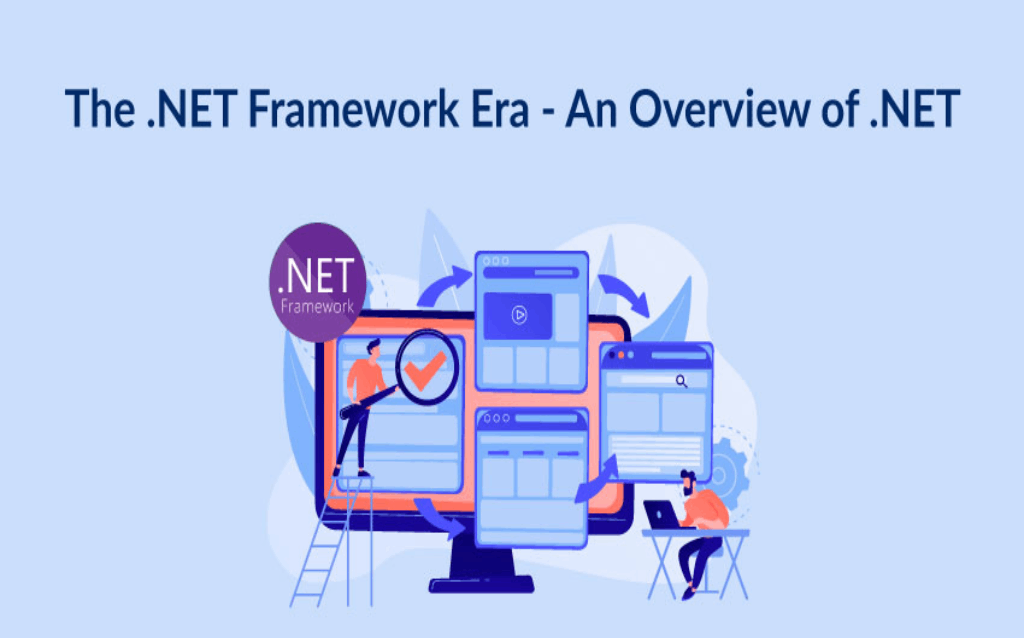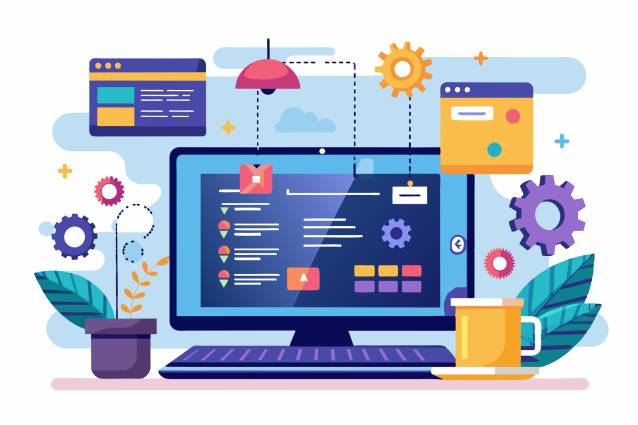Introduction
Microsoft developed and designed an easy-to-program .NET software development framework and ecosystem which allows easy desktop and web application engineering. Even though it is a popular free platform, the developers get to use the entire programming environment in their software development phases.
Businesses that are looking for a myriad of features like web-based services, desktop software, and cloud infrastructure support prefer to go for different types of applications which are developed in the .NET framework.
The .NET Framework era
The work on the .NET framework started way back in late 90s by Microsoft when the world was embracing computers and internet had started connecting the entire world. Those were the initial days of the IT boom and the C/C++ developers had to keep security operations, active memory management, and other low-level efforts in mind while developing any application. Microsoft wanted to improve the development experience and relieve the programmers from keeping everything in mind while developing a software program.
Microsoft .NET Development evolved and C# programming language was released in 2002. This language had a design similar to C++ and the .NET framework was meant for Windows-based computers and servers. This framework included WinForms which was a GUI (graphic user interface) library for desktop applications. Using dot net development principles, GUI based programs could be easily written which became extremely popular due to the ease-of-se.
Microsoft .NET Development also included ASP.NET which was a framework for web, and hence can assist in developing web applications. ADO.NET was meant for data access and all these elements were driven by Common Language Runtime (CLR) which helped the programmers to compile and execute managed code.
The .NET CORE era
In 2016, .NET Core was introduced by Microsoft and this new cross-platform, cloud-friendly, and open-source version of the framework became the stepping stone of dot net core development. It was announced by Microsoft two years before in 2014, and eventually Microsoft started integrating existing services to work with .NET Core. Some that didn’t receive official ports, like Windows Communication Foundation (WCF), were substituted by alternatives sourced from the community as the entire framework was on open source.
In 2018, Microsoft open-sourced Windows Presentation Foundation (WPF), Windows Forms, and WinUI frameworks. Meanwhile, in 2016, Microsoft acquired Xamarin, a leading platform provider for mobile app development and made it open source as well.
The .NET 5 and .NET 6 eras
In 2019, Microsoft made the announcement that the .NET 5 big release would tie the ecosystems together. Due to COVID-19, the release was delayed, however the .NET 5 unified development platform was finally introduced in November 2020.
The .NET 5 provides a lot of features to build applications on Windows, Linux, macOS, iOS, watchOS, Android, tvOS, or using WebAssembly, and uniting the ecosystems helped the dot net development program immensely. Being a successor to .NET Core 3.1 and .NET Framework 4.8, the Microsoft .NET 5 puts the fragmented .NET world into order and allows the developers to look at a solution comprehensively.
The Microsoft .NET 5 platform comes with new APIs (Application programming interface), language features, and runtime capabilities. Since .NET 5 includes ASP.NET Core, Xamarin, Entity Framework Core, WPF, WinForms, and ML.NET, it can help the programmer build robust and modern web applications.
While .NET 5 set the unified the various open source applications, the newest .NET 6 version launched in November 2021, with Visual Studio 2022 will build projects across cloud, browser, IoT, mobile, and desktop environments, enabling all to use the same .NET libraries, SDK (software development kit), and runtime.
Microsoft .NET 6 works on various platforms like Linux, macOS as well as windows and hence covers all types of operating systems and aides the developers in integrating applications on various platforms further. Today, it has embraced all latest technologies like desktop cloud, machine learning (ML), gaming APIs, and building web pages incorporating HTML, CSS as well as JavaScript.
One of the most noticeable .NET 6 features is .NET MAUI (Multi-platform App UI) that acts as the cross-platform framework for building native desktop and mobile apps with C# and XAML.
.NET 7.0 is in the development phase and was announced by Microsoft in 2022.
What is .NET development platform?
Microsoft .NET comes in four flavors: .NET Framework, .NET Core, Xamarin, and Universal Windows Platform (UWP), and when a solution is designed using all these four elements, it is known as the .NET development platform. Each component has its own frameworks and libraries which helps the developers to build the wide range of applications.
The first .NET Framework released back in 2002 included three main application models – Windows Presentation Foundation (WPF), Windows Forms, ASP.NET Forms and Base Class Library (BCL). Since this first .NET Framework supported only Windows-based devices, there was a need for a cross-platform package.
Microsoft .NET Core which was released in 2016 was a cross-platform re-build of .NET Framework and unlike the first version, developers now could use the product on Linux and Macintosh operating systems and create applications that were not tied to the Windows family. Microsoft .NET Core includes ASP.NET Core and Universal Windows Platform (UWP) and different versions of this program can also be installed side by side on the same device which aims at integrating cloud to the solution.
In 2016 Microsoft also introduced .NET Standard, a library that combines APIs from .NET Framework, .NET Core, and Xamarin allowing the developers to use a single base-class library rather than working on three different ones related to each .NET implementation. This step unified the ecosystems and made the job of the solution architects and programmers easier.
UWP provides a common type system, APIs, and application model for all devices running on the latest Microsoft OS Windows 10 and above. So, UWP enables the development of universal applications for personal computers, tablets, Xboxes, Surface Hub, HoloLens, or Internet of Things (IoT) devices. Unfortunately, .NET 5 and .NET 6 will not be coming to UWP project types.
Common Language Runtime (CLR) is the main feature of .NET, which is nothing but an application virtual machine that manages memory, implements code access security, verifies code safety, and provides commands for execution of threads and code. CLR allows the programmers to design systems with multiple languages, as CLR enables them to communicate with each other and the languages can integrate their behaviors on CLR.
The languages that one can use with .NET can be ultimately divided into two major groups. The first group is the main officially supported languages by Microsoft like C#, F#, and Visual Basic. All three programming languages saw great improvements within the .NET 6 release. C# 10 and F# 6 were introduced, both aiming at simplifying code and making it more performance oriented.
The second are the rest of the languages that are CLI (common language infrastructure) compliant. This includes about 25 active CLI-compliant languages, including C++/CLI, IronPython, Oxygene, Phalanger, and more. IronRuby was an active language in the older versions, however has become obsolete in the latest .NET versions.
When to use the .NET?
-
Scalable products
Microsoft .NET platform provides a scalable environment for the growing businesses and allows the redesigning of ongoing applications. This helps to match the latest needs of the business keeping the agile framework in mind.
-
Cross-platform needs
In case you need an application that works across platforms on web as well as mobile platforms, .NET technology will be a great choice. The app can be developed even for different OS like windows, Linux and mac simultaneously without putting much development effort.
-
Enterprise-scale infrastructures
.NET developers have the support of the worldwide community in which more than 60,000 are of active Open Source Software (OSS) and more than 3700 the proprietary software owned by Microsoft. The .NET development mainly supports three programming languages- F#, C#, and Visual Basic. The IT giant provides the widest toolset possible to build and cross-integrate enterprise products, both internal and public ones which in turn supports a robust enterprise mobility ecosystem.
Benefits of .NET Framework Programming
-
Object-oriented software development model
Microsoft .NET is based on object-oriented programming (OOP) which simplifies programming by making the code manageable, easier to test during SIT (system integration tests) and UAT (user acceptance test), and respond to recurring issues. The programmers love it because it eliminates unnecessary programming and makes it possible to reuse code and components. This in turn saves time, and cost of development and the entire software production cycle is shortened.
-
Reliable and simple caching system
Everyone has heard about cache which means storing data in a temporary storage place, which can be called faster when needed. The caching system in .NET is robust and simple to use and the Object Cache class allows the .NET programmers to create a custom cache implementation to be used for improving the performance and scalability of Windows client and server applications.
-
Cross-platform design of .NET Core
As discussed earlier, .NET Core is a cross-platform .NET implementation that allows the code to run on multiple operating systems including Windows, Macintosh and Linux and this benefit enables companies to reach the widest variety of platforms staying within the .NET ecosystem.
-
Robust and flexible deployment and easy maintenance-
Dot net Core can be installed as a part of the application and the modular design contemplates including all the dependencies which are needed for the installation. The deployment is as simple as copying a folder.
-
Universal .NET Standard
The latest version of the .NET ecosystem which was launched in 2016, has been enhanced with a large class library called .NET Standard. It is based on the number of base class libraries for .NET Framework, .NET Core, and Xamarin. These are used to work with common functions such as graphics rendering, database interaction, and manipulations with XML documents. The .NET Standard library greatly simplified the software engineers’ work as the library supports all dependent libraries across applications. Before .NET Standard was released by Microsoft, a developer had to redevelop an application or a library for the new platform and then distribute all the updates across various platforms.
-
Visual Studio IDE
Visual Studio is a Microsoft Integrated Development Environment (IDE) which is used for developing, debugging, and publishing applications across all platforms, including Android and iOS. Visual Studio is integrated with .NET suite and it provides the features of a language-specific environment.
-
.NET popularity and community
Across the globe since there are many .NET developers, almost any issue can be resolved with the help of the community members. Since .NET Core is open source, its libraries, runtime, and compiler are available on GitHub and have many contributions. The community talks to each other on various platforms like Reddit and other IT forums and seek help from each other’s expertise.
According to the Stack Overflow 2021 survey, Microsoft .NET Framework with .NET 5 and .NET Core placed first and second positions respectively as the most used frameworks beyond web development. ASP.NET was ranked fifth among the most popular web frameworks.
-
Automatic monitoring in ASP.NET
The Windows Web Server strictly monitors web pages and applications that run on it and in case there are any issues such as memory leaks or infinite loops, it immediately alerts the administrator about it.
-
Active Microsoft support
Since it is a Microsoft product; the best possible support is available. The company is actively focused on innovating it and regular version launches are a proof of that.
-
Relatively easy migration from .NET 5 to .NET 6
Microsoft knows that it will release newer versions on regular intervals and hence has kept the process of migration for companies easy.
How Aspire can help?
We at Aspire software Consultancy (ASC), provide dot net core development services that are one of the best in the industry. We are an ISO certified company and a NASSCOM member and our dot net certified developers will help your business by creating unique and robust web applications that are exceptionally functional. We are of the top .net development services provider in US, and have been serving more than 300 clients since our inception 13 years ago.












